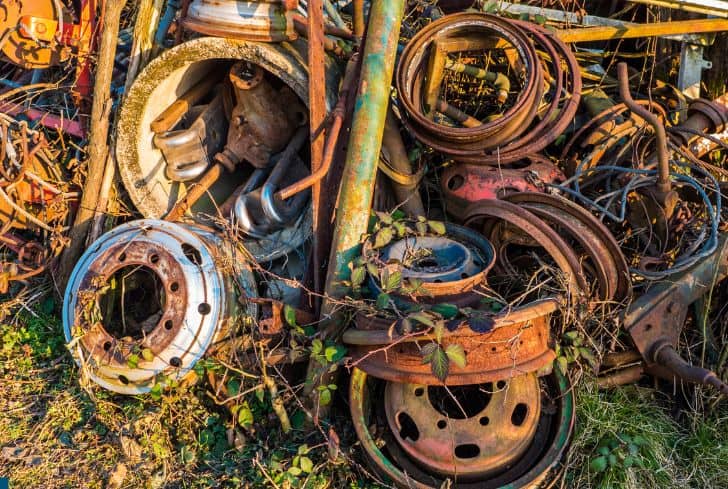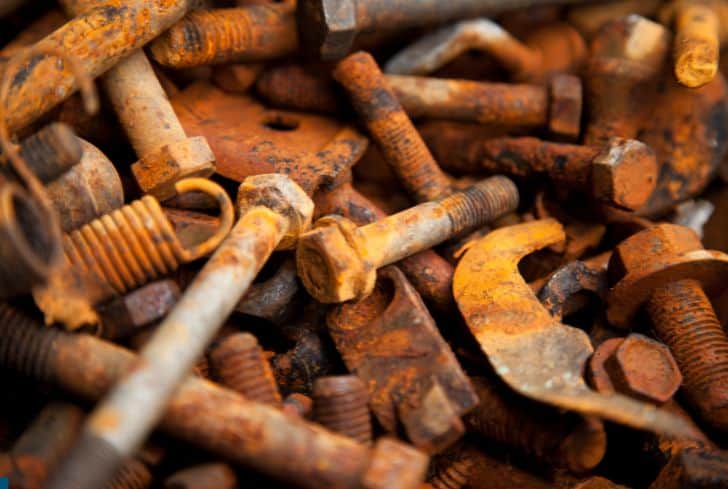Gold, silver, copper, and iron; are all types of metals commonly used. Let’s not forget stainless steel a material we find in every industry, much like the other items that identify as metals.
There is no doubt that human existence has come to rely on the use of this non-renewable resource. From creating spears and objects for defense back in the day to aesthetic benefits, metals serve many functions.
So, let’s ask the much-needed question – is metal biodegradable? It is a durable substance, but it doesn’t last forever. What is the decomposition process then like? Does it break down like organic matter and contribute to the ecosystem, or does it remain the same, a nonbiodegradable human waste? Keep reading to find the answers!
Are Metals Biodegradable?
No, metals are not biodegradable. Well, some are, but the duration it takes is quite prolonged, as long as fifty to two hundred years, if not more. There are many types of metals, most of which can last a long time. For example, pure gold and silver can last thousands of years without breaking down.
But if a metal item is corrosive, it does not mean it is biodegradable. Organic decomposers like fungi, yeast, and bacteria will not break it down because it offers no nutritional value to them.
Instead, oxygen will decompose the material, causing corrosion. It will break down fast when the right environment is introduced, like bleach to stainless steel.
Metals like pure silver and gold won’t decompose even in landfills, which is why you can, even after thousands of years, a pirate’s treasure is still valuable.
On the other hand, iron and aluminum will break down because of the combination of environmental factors like time, oxygen, and moisture, but this doesn’t mean they are biodegrading. Microbes and other organic creatures that accelerate decomposition cannot break down metals because there is no nutrient or benefit in it for them.
The metals that are susceptible to rust or corrosion don’t biodegrade, but the reaction that occurs from oxygen exposure causes them to disintegrate, which is why you may not see them after some decades. They have not been broken down by microorganisms but have disintegrated.
Here is the melting point of a few of the metals:
| Metal | Melting Point |
|---|---|
| Nickel | 1453°C (2647°F) |
| Silver | 961°C (1762°F) |
| Tungsten | 3400°C (6152°F) |
| Stainless Steel | 1375 – 1530°C (2500-2785°F) |
| Aluminum | 660°C (1220°F) |
| Carbon Steel | 1425-1540°C (2597-2800°F) |
| Titanium | 1670°C (3038°F) |
| Zinc | 420°C (787°F) |
| Niobium | 2470°C (4478) |
| Brass | 930°C (1710°F) |
| Copper | 1084°C (1983°F) |
| Molybdenum | 2620°C (4748°F) |
| Inconel | 1390-1425°C (2540-2600°F) |
| Tantalum | 2980°C (5396°F) |
| Chromium | 1860°C (3380°F) |
And this is what high temperature can do this to metals.
Note that the duration it takes metal to decompose depends on its size. In other words, larger metals will break down slower than smaller ones.
Are Metal Cans Biodegradable?
Metal cans are not biodegradable. Think of them like rocks and sand, but precious or more valuable. Metals are non-renewable natural resources whose formation requires centuries or even longer, providing a rigidity that bacteria and fungi in the soil cannot or wouldn’t break through.
For biodegradation to occur, the material in question must be organic matter, which means it must have been previously alive.
Metals are the results of long-term formation processes, and we mine and process them into the useful materials they are today. And by now, you must already know that there are many types of metals: tin, aluminum, copper, iron, and molecular compounds like polymeric sulfur nitride.
Are metal cans biodegradable? Well, the short answer is no, and the reason is that they don’t contain nutrients that the microbes mentioned earlier can feed on.
For biodegradation to occur, the substance must be organic matter, soft, moist, and capable of breakdown.
Metal cans can be broken down by weather and time, but it depends on the type of metal in question. If it is corrosive, then rest assured that everything will eventually dissipate, though it may take a considerable period. The size of the material also determines how long degradation will take.
But generally, a metallic substance cannot be broken down by the organisms required for biodegradation.
If you don’t meet a metal waste item in the spot you left it decades ago, it will likely be the result of rust or corrosion, which causes this sort of material to biodegrade as fast as five days after exposure.
Are Metal Straws Biodegradable?
No, metal straws are not biodegradable, but they are still more eco-friendly than popular plastic products. Metal straws are not organic products; they are made from non-renewable resources, which are also renowned for their inability to decompose naturally.
Biodegradable straws are becoming bestsellers in the market because of their ability to reduce our negative impacts on the environment. Ready to go green? Well, ditching plastic straws for biodegradable or metal options is a great idea, considering that you can dispose of them without fearing a toxic substance affecting the environment.
If you are ready for the green movement, ditching single-use items is one way to get started. Fortunately, greener living also helps you save money.
A metal straw is a convenient piece to own. It saves you money on replaceable straws, is easy to clean, and is relatively compact so that you can carry it everywhere and use it anywhere.
However, it does not decompose naturally. Fungi, bacteria, and yeast are prime examples of microorganisms that break down organic matter, but they cannot colonize items like plastic straws to break them down into humus.
So, you can invest in a cheaper and more environmentally friendly alternative to plastic straws, but the downside is that metal options are not biodegradable. You will enjoy the durability offered, which is worth it in the end.
How Long does it Take Metal to Decompose?
A minimum of thirty years. But it can also take up to two centuries for metals to decompose. Overall, it depends on the size of the metal, thickness, and environment it is in. The metal waste from cans and smaller metallic containers can break down in thirty years, while the larger and denser ones can take two hundred to five hundred years.
Metal packaging is the go-to option for obvious reasons. It is airtight, safe from rodents and pests, and often keeps the content fresh, preserving the quality, taste, and texture.
Therefore, it is customary to see many metallic items around the home or non-domestic sector. There are different types of metals: chemical elements, alloys, and molecular compounds, and each class decomposes at different rates. But also, some metals do not decompose at all.
Iron is degradable and technically takes up to hundred years to break down. Note that the duration technically depends on the size and thickness of the product.
Tin is another type of metal that is popular for production. It is a rare, naturally occurring metal that must be used sparsely because of our limited supply. So, another form of metal is added to it during the manufacturing process.
Tin requires fifty years for decomposition to occur, and the overall rate depends on environmental factors and the size of the waste item.
On the other hand, aluminum will break down in two hundred years because it is a more resistant metal.
Metal items used for construction may take longer to degrade because they are often more reinforced. Exposure to extreme temperatures makes sure of this so that durability will not be a concern.
Does Metal Remain in the Landfill Forever?
Mostly, yes. Unless we are talking about a corrosive metal, expect the waste item to remain in the landfill indefinitely. It does not decompose because it is inorganic and merely sits there. In contrast, some metals, for instance, tin, are more susceptible to rust, so they will likely dissipate before you know it.
Metals are friendlier to the environment than plastic for many reasons. Plastic is toxic and pollutes the environment during its slow decomposition stage. Furthermore, it does not entirely go away but rather dissipates into microplastics that are everywhere!
So, when choosing between plastics and metals, metals always win.
However, metals don’t decompose. The activities of bacteria and fungi cannot break them down, and it takes longer periods for the weather and other environmental factors to win against this material.
What happens when you don’t recycle your waste metal item but allow it to make its way to the landfill? Does metal remain in the landfill forever?
A resounding yes, in most cases. But again, the typical metal containers that are used for everyday packaging needs are not as rigid as the longer-lasting options.
In other words, regular metal waste items will be susceptible to corrosion so that they will dissipate in the landfill. The smaller the product, the faster dissipation occurs.

Is Metal Harmful to the Environment?
Yes, the process of mining metals is what is harmful to the environment. It rips off a huge chunk or portion of the earth’s surface, leaving it exposed and unable to support biodiversity. Furthermore, these industrial activities expose inhabitants of mining areas to toxic atmospheric substances.
Even the environment is not spared from toxic poisoning by substances like mercury, chromium, and lead.
Metal is harmful to the environment, even though it is a durable product that can be recycled.
Chemical poisoning is another danger. These chemicals are harmful to biodiversity, especially aquatic creatures. For instance, chemical waste from mining and manufacturing facilities may enter water bodies, pollute them, and kill marine creatures.
Even after these metals serve their purpose, if we fail to dispose of them properly, they release chemicals into the environment during their slow decomposition process.
Does Metal Decompose Faster Than Plastic?
We would say yes and no. It depends on the size of the metal and plastic and the type. There are different types of metals, just as there are various metals. The average plastic container takes twenty to five hundred years to decompose, while plastic bags require up to a thousand years.
On the other hand, metals can take between twenty to two hundred years for decomposition; then again, they may not decompose at all!
Metals like pure silver and gold may take forever to break down if it even happens at all.
But again, it is worth mentioning that plastics never really go away. They only break down into smaller particles called microplastics and travel around the ecosystem.
Does metal decompose faster than plastic? The answer depends on the items in comparison.
How to Dispose of Metal?
Recycling is the best way to get rid of your metal waste. If it is made from steel and aluminum, like the containers food and beverages are packaged in, you can put it in your curbside recycling bin. However, you should take it to the scrapyard or recycling center if it is a larger metal waste product.
If you are taking it to the recycling center, we recommend asking if that kind of waste is allowed so that you don’t make an empty trip. You can also use a recycling locator to look up the nearest place to recycle your metal item.
Conclusion
Metal is a nonbiodegradable item. It does not break down, although the less reinforced ones corrode and dissipate with time. The nonbiodegradability of metals is a downer because it means metal items that we don’t dispose of properly end up in landfills indefinitely.






